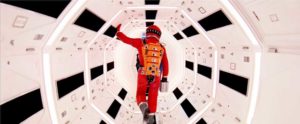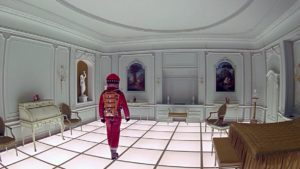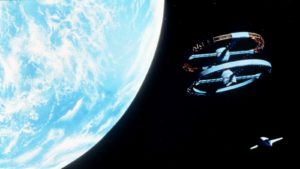 Attend: Program Notes
Attend: Program Notes
2001: A Space Odyssey | Stanley Kubrick | UK, US | 1968 | 139 minutes
Cinesthesia, Madison Public Library Central Branch, Wednesday, April 4, 6:00pm»
In his Cinesthesia program notes, Jason Fuhrman traces the evolution of Stanley Kubrick’s 2001: A Space Odyssey from a nascent speculation on humanity’s role in the cosmos to a monumental work of cinematic poetry that permanently altered movies and our collective imaginations.
I tried to create a visual experience, one that bypasses verbalized pigeonholing and directly penetrates the subconscious with an emotional and philosophic content. . . . I intended the film to be an intensely subjective experience that reaches the viewer at an inner level of consciousness, just as music does. . . . —Stanley Kubrick, 1968
The Universe is not only stranger than we imagine; it is stranger than we can imagine. —J.B.S. Haldane
Although the titular year has come and gone, 2001: A Space Odyssey will never be out-of-date. When Stanley Kubrick’s mind-bending sci-fi symphony was first released in April 1968, no had seen anything even remotely like it before. Fifty years later, the film’s epic scale, technically flawless special effects, uncompromising dedication to detail, and timeless, enigmatic beauty have yet to be surpassed. At once a well-preserved cultural artifact, a giant leap forward in the evolution of cinema, a transcendent, awe-inspiring audiovisual experience, and the most ambitious, expensive avant-garde film ever made, 2001 stretches the limits of its medium to accommodate an infinite range of possible interpretations. As human technology advances and the space frontier recedes, Kubrick’s masterpiece endures because of the purity of his artistic vision and the film’s potential to stimulate our deepest yearnings and impulses.
The embryo of the idea for 2001: A Space Odyssey allegedly came to Kubrick when he happened upon a RAND Corporation report on the possibility of extraterrestrial intelligence. In the pioneering director’s words, “Most astronomers, and other scientists interested in the whole question, are strongly convinced that the universe is crawling with life; much of it, since the numbers are so staggering, equal to us in intelligence, or superior, simply because human intelligence has existed for so relatively short a period.”
Kubrick reached out to British science-fiction author Arthur C. Clarke in late March 1964, writing that he would like to discuss the possibility of collaborating on what he termed “the proverbial ‘really good’ science-fiction movie.” By early May 1964 Kubrick agreed that Clarke’s short story “The Sentinel,” about the discovery of an alien artifact on the moon, could provide the basis of a screenplay. It begins like this:
The next time you see the full moon high in the south, look carefully at its right-hand edge and let your eye travel upward along the curve of the disk. Round about two o’clock you will notice a small, dark oval: anyone with normal eyesight can find it quite easily. It is the great walled plain, one of the finest on the Moon, known as the Mare Crisium—the Sea of Crises. Three hundred miles in diameter, and almost completely surrounded by a ring of magnificent mountains, it had never been explored until we entered it in the late summer of 1996.
Clarke and Kubrick spent two years transforming this short story first into a novel and then into a script. The idea was to let their imaginations soar and completely develop the story before embarking on the script, which would be derived from the novel. In practice, both the novel and the screenplay were written simultaneously, with feedback in both directions. Meanwhile, Kubrick read every popular and semi-popular book on science that he could obtain, as well as viewed every available science-fiction film.
Clarke presented Kubrick a rough draft of what was initially titled Journey Beyond the Stars around Christmas 1964. At this stage, the existing manuscript, which stopped at the Star Gate sequence, consisted merely of the first two-thirds of the book. However, Kubrick was able to sell the idea for a film based on this draft to MGM. The projected budget was $6 million and it was to be ready by the fall of 1966. As the story began to take shape, Kubrick proceeded to design the visual elements of his project. The perfectionist director demanded absolute realism in terms of present and near future technology.
In The Making of 2001: A Space Odyssey, Piers Bizony presents a fascinating, exhaustive account of the film’s elaborately complex pre-production process, which I have attempted to summarize as follows.
Towards the end of January 1965, many prominent space writers, scientists and researchers happened to be passing through the New York area all at once, including two men from a small space consultancy company who were meeting with publishers in connection with their own book on the theme of extraterrestrial intelligence: Harry Lange and Frederick Ordway. Harry Lange had worked for NASA on advanced space vehicle concepts and was well versed in the most highly classified details of propulsion systems, radar navigation, docking techniques, and other matters pertinent to U.S. aerospace technologists of the day. His job had been to visualize nonexistent vehicle concepts, so that NASA and its corporate collaborators could communicate their ideas for the future. Frederick Ordway had developed an illustrious intellectual and commercial career with NASA and a wide variety of first-rate industrial and academic institutions. His scientific expertise was reinforced by a keen understanding of the public relations process by which large and complex organizations try to inform the world of their activities.
Clarke met with Lange and Ordway and explained that he was working with Kubrick on a film about contact with extraterrestrials. The next day, all four of them spent what Ordway has described as “a mentally exhilarating afternoon” discussing concepts and examining the possibility of collaboration. Then Lange and Ordway were asked formally for their assistance. Ordway would become principal technical adviser and Lange would map out a range of detailed and realistic spaceship configurations.
Ordway began to establish channels of communication with dozens of real aerospace manufacturing companies and persuaded them how beneficial it would be for their own publicity if they were involved in Kubrick’s movie. For example, the large Pan American symbol on the side of the Orion space liner was used in exchange for information about the airline’s ambitions for the future. NASA, IBM, Honeywell, Boeing, Bell Telephone, RCA, General Dynamics, Chrysler, General Electric, and Grumman all provided extensive documentation and even actual hardware. They presented theoretical outlines, drew up instrument panels, and discussed in minute detail how astronauts of tomorrow would spend their days.
Much of what NASA and the aerospace companies told Kubrick and his advisers was in the gray area between hard knowledge and pure speculation. And once all this data had been accumulated, it would have to come to life on screen. Production designer Tony Masters took command of the overall art direction, particularly the planning of the control decks, passenger compartments, pod bays and so on. (The surreal hotel room at the film’s climax was his handiwork.) He was competently assisted by John Hoesli, who helped to manage the inconceivable day-to-day tasks of set construction and prop-making.
With Ordway producing reams of paperwork and material, Lange mapped out the spaceships, control panels, suits and moon bases during an intense six months in New York from February up until June 1965, after which he transformed several of the main ideas into fully developed technical drawings.
Then the entire production moved across the Atlantic to the giant MGM production facility in Boreham Wood near London, where most of the ten soundstages would be occupied by 2001: A Space Odyssey. Perhaps the greatest challenge Kubrick faced was to find ways to depict things that had never been seen, as well as things that were in fact “unthinkable.” To this end, he assembled an extraordinary special effects team under the direction of Con Pederson, Wally Weevers (his SFX man from Dr. Strangelove), and veteran Tom Howard, who had worked on optical effects for more than twenty years. He also hired a very young and enthusiastic man named Douglas Trumbull, who would subsequently build a dazzling career on films like Close Encounters of the Third Kind (1977) and Blade Runner (1982).
For his part, Lange set about translating the ideas he had come up with into models that could be photographed convincingly. The set designers urgently needed to know what the exteriors were supposed to look like, so that live-action photography would be consistent. Lange assembled a team of modelmakers and concentrated on turning his drawings into credible three-dimensional objects. Kubrick wanted to be able to shoot them from all angles, at all scales and speeds, so that he could choose the best sequences later on during the editing process. Consequently, the models had to be extremely detailed and look perfect. Certain elements had to be fabricated in what amounted to a factory environment. At the height of this massive construction effort, 103 modelmakers from various specialist disciplines were employed on multiple projects. There were boat builders, architectural students, fine artists, sculptors, lithographers, metalworkers, and even some ivory carvers fresh off a whaling boat.
Full-size space pods, pressure suits and helmets required the services of independent industrial companies. The suits were manufactured by a well-respected Manchester firm, Frankenstein (Air and Sea Rescue, Division of). Master Models, a London company, molded the helmets, along with chest packs and several spacecraft inner shells. Pod interiors and instrument layouts were produced by the British Hawker Siddeley aircraft company to specifications that were so exact, they might just as well have been working on a genuine aerospace contract. Hawker’s team leader Arthur Cole remembers:
We were contracted to provide consultancy during the early stages of production, and our responsibility was communications systems, voice, video, radar, navigation and control systems, altitude and orbit, remote manipulators and so on. Between us we derived many instrument layouts and provided advice on the likely shape of various structural features such as antennas, propulsion and control jets, and relevant hatch and docking systems.
As far as Kubrick was concerned, if 2001 was to be believable on a technical level, then no detail was too minor to consider. In his painstaking pursuit of complete authenticity, the director consulted constantly with more than thirty technical experts, while supervising every aspect of the production. Altogether there were 25 effects people, 35 designers and 70 other staff working on this monumental work of art.
During the production of 2001, an elaborate “command post” was set up at Boreham Wood in order to keep track of the incalculable number of technical details involved. In his behind-the-scenes account, Herb A. Lightman writes, “It was described to me as a huge, throbbing nerve center of a place with much the same frenetic atmosphere as a Cape Kennedy blockhouse during the final stages of Countdown.”
Shooting finally began on December 29, 1965 with the excavation of the monolith on the lunar surface. From January 8, 1966, it took a month to film the space station and moon base sequences. Then the interiors of the Discovery I spacecraft were filmed with actors Gary Lockwood (Frank Poole) and Keir Dullea (David Bowman) through the spring of 1966. In a production abounding with marvels of cinematic technological innovation, the centerpiece was the control room of the Discovery, for which the Vickers-Armstrong Engineering Group constructed a real centrifuge shaped like a Ferris wheel at a cost of $750,000. It was forty feet in diameter and rotated at three miles per hour. A closed-circuit television enabled Kubrick to direct the filming from outside the wheel. Inside, two kinds of camera setups were used: either the camera was attached to the wheel and rotated with it or the camera was secured to a small dolly which remained with the actors at the bottom of the rotating set (such as when Poole jogs).
The physical production paused for more than a year while Kubrick figured out where and how to film the opening “Dawn of Man” sequence. He had originally intended to go on location in Africa, but eventually decided on building sets. Meanwhile, the art-department and special-effects teams were perfecting the film’s multitude of exceedingly complex and difficult special-effects shots, a job which took more than 18 months and cost $6.5 million. It was necessary for Kubrick’s team to conceive, design, and engineer completely new techniques in order to produce the film’s visual effects. Among the methods they developed was the front-projection system, which entailed using a still photograph as a background for a shot by casting the image onto a mammoth screen with a unique kind of projector, without being visible on the cast or props in the foreground. This made it economically feasible to shoot large-scale epics in the sound studio and proved especially significant for the future of the film industry.
In the words of Bizony, “The final product of nearly three years’ intense effort at Boreham Wood was the most realistic space fiction film ever made, bar none. By any standards, 2001 still looks convincing today.” Furthermore, as Lightman points out, “A film technician watching 2001 cannot help but be impressed by the fact that the complex effects scenes have an unusually sharp, crisp and grain-free appearance. . . .” This follows from “a deliberate effort on Kubrick’s part to have each scene look as much like ‘original’ footage as possible.” Therefore, “he automatically ruled out process shots, ordinary travelling matte shots, blue-backings and most of the more conventional methods of optical printing.”
Special-effects work, editing, and other post-production labors continued right up to the April 1968 premiere in Washington, D.C. Several scenes were omitted, such as the purchase of a bush baby for Dr. Floyd’s daughter, Squirt; routine activities on the moon; shots of the astronauts’ families; and shots of the Ping-Pong table, shower and piano in Discovery. After a screening for the MGM executives in Culver City, California, Kubrick removed the prologue and all voice-over narration from the film. Following its New York and Los Angeles premieres, he cut nineteen minutes from the film’s original running time of two hours and forty-one minutes, shortening scenes such as “The Dawn of Man” and Poole exercising.
In the end, Kubrick’s magnum opus took more than four years to develop and make, involved hundreds of people, and cost $10.5 million. Despite hostile early reviews, by 1972 the film made $31 million worldwide. 2001 won an Academy Award for Best Special Effects, the only Oscar Kubrick ever received.
It was selected by the Library of Congress in 1991 for preservation in the National Film Registry as being “culturally, historically, or aesthetically” significant. The film operates on multiple levels simultaneously and its power remains undiluted by the passage of time. What Kubrick described as a “mythological documentary” has profoundly impacted not only cinema but also our collective imaginations. While 2001 scrupulously adheres to the scientific realities of interstellar travel, the film guides us on a journey through inner space. Via pure visual poetry, 2001 compels each viewer to discover the deeper meaning and significance at its core. As Kubrick said, “However vast the darkness, we must supply our own light.”
